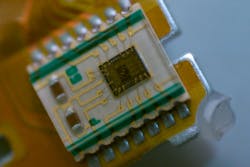Sensor Interface Relieves Complexity from Smartphones to Cars
With falling sensor sizes and prices, manufacturers are increasingly giving devices the ability to search their surroundings for valuable data. Some are installing sensors into cars to measure pollution levels in cities and others are putting chemical sensors in wristbands to analyze the chemical content of an athlete's sweat.
But that ambition has also created headaches for electrical engineers, who have to integrate new sensors without drawing too much extra battery power or generating too much heat.
Now an industry group is trying to offer some relief. Last week, the MIPI Alliance released new instructions for creating an interface that links sensors and processors. Those sensors can range from accelerometers and actuators to cameras and biometric devices. The specification is known as the Improved Inter-Integrated Circuit, or I3C.
The new standard is primarily a reaction to the increasing complexity of mixing new and mainstay sensors inside everything from virtual reality headsets to self-driving cars. The trend is in sending sensor data into processors where it can be fused with special software to make more detailed conclusions. But that must be done without increasing power consumption and heat.
For years, electrical engineers have used multiple interfaces to do so, according to Joel Huloux, chairman of the board of MIPI Alliance and director of lobbying and standardization for the microcontroller group at STMicroelectronics. That fragmentation can increase the pin counts inside devices, resulting in greater complexity and costs for parts.
The I3C standard uses a two-wire interface that includes elements from the Serial Peripheral Interface Bus, as well as general purpose input-output (GPIO) and Universal asynchronous receiver/transmitter (UART) technologies. This helps simplify sensor integration and ease the pin count problem, Huloux said in a recent column for the Institute of Electrical and Electronics Engineers’ Beyond Standards blog.
The standard also contains parts of an earlier interface known as the Inter-Integrated Circuit or I2C, which was invented by Philips Semiconductors, first debuted in 1982, and last updated in 2014. The new standard is backwards compatible with I2C technology, according to the MIPI Alliance.
Rick Wietfeldt, chairman of the MIPI Alliance Technical Steering Group, said in a statement that “most types of I2C devices can coexist with I3C devices on the same bus, enabling vendors to migrate current I2C designs to the new standard. Likewise, newly designed MIPI I3C devices can work on existing legacy I2C buses.”
A draft of the I3C specification has been available to MIPI Alliance members since August.
Founded in 2003, the MIPI Alliance has more than 250 members focused on interfaces for smartphones and applications influenced by mobile technology, like cars and medical devices. The companies that worked on I3C include Analogix, Intel, MediaTek, NXP Semiconductors, Qualcomm, Sony, Synopsys, and STMicroelectronics.
Although the I3C standard was originally developed for sensor devices, it can also be used in lower bandwidth applications like power management and industrial control. It supports a minimum data rate of 10 megabits per second and clock rates up to 12.5 megahertz, according to the MIPI Alliance.
The I3C specs will also factor into upcoming MIPI standards, which include Touch for optimizing the integration of touch sensors, and Debug for improving how test equipment locates errors in software and hardware. The latest version of CSI, a standard that defines how multiple cameras pool video, will also use it.
The MIPI Alliance started work on the standard in late 2014 so that it would be ready for things like widespread near-field communications and infrared sensing. In the 2014 announcement, Ken Foust, then chair of the Sensor Working Group, predicted that the interface would be an evolution of I2C and SPI. “This new specification will become a superset of both,” he said.
About the Author
James Morra
Senior Editor
James Morra is the senior editor for Electronic Design, covering the semiconductor industry and new technology trends, with a focus on power electronics and power management. He also reports on the business behind electrical engineering, including the electronics supply chain. He joined Electronic Design in 2015 and is based in Chicago, Illinois.


